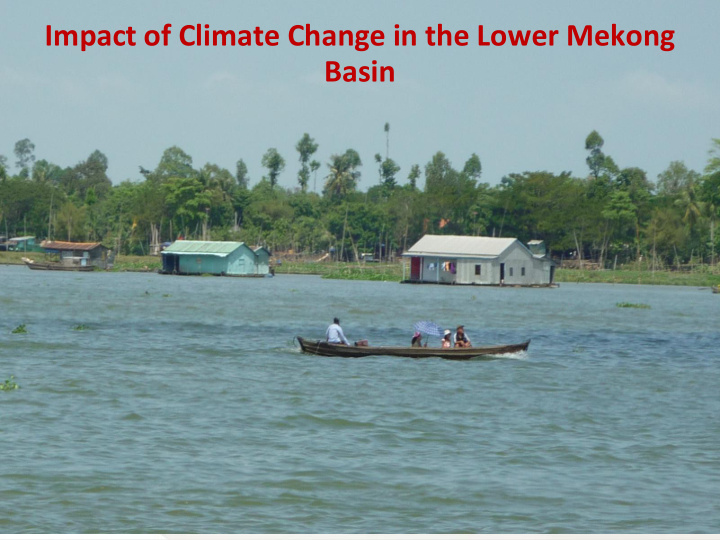



Impact of Climate Change in the Lower Mekong Basin
Lower Mekong Basin and its Vulnerabilities • Among the most exposed and vulnerable population in Asia & Pacific • Mekong River as source of food, livelihood, transportation, freshwater • Evidence of negative anthropogenic impacts on Water Resources, Agriculture Systems, Food Security, Ecosystems, Biodiversity and Health
Mekong Delta and its Vulnerabilities 13 provinces and half of them highly vulnerable to Annual Mekong Flooding Coastal provinces affected by sea water intrusion and contaminated soil. Extreme weather conditions led to Droughts in most of the provinces Typhoons are increasing
Emerging Threats • Sea level rise could be anywhere between 30cms and 1 metre by 2100, although the upper end is more likely. If it does reach 1 metre, 90 per cent of the Delta would be inundated every year. • Even by 2030, the sea level rise could expose around 45 per cent of the Delta’s land area to extreme salination and crop damage through flooding . • The dry season flow of the Mekong River is projected to drop by between 2.0 to 4.0 per cent by 2070, which would another factor aiding Salinization and water shortages . • Declining crop productivity would particularly affect the spring rice crop, which is expected to fall by 8 per cent by 2070. Source: Oxfam
DISASTER RISK REDUCTION AND CLIMATE CHANGE ADAPTATION FROM THE PERSPECTIVES OF NATIONAL AND LOCAL GOVERNMENTS AND COMMUNITIES IN THE LOWER MEKONG BASIN OF SOUTHEAST ASIA
Impacts observed by Provincial Authorities ( An Giang & Ben Tre) • Increase variability and severity of the weather causing floods, droughts, river bank landslide, water pollution, and salt invasion, epidemic to the people, livestock and plants. • Changed pattern of water resources in terms of rainfalls . • Decreased agriculture produce and food security such as growth and productivity of plants, crop schedules . • To forestry, climate changes’ impacts badly influence cajuput forests . • To transportation: important road lines are at risk of flooding, erosion and landslide, etc.
Impacts observed by Provincial Authorities (An Giang & Ben Tre) • Climate changes’ impacts to industry and constructions : facing more frequently with flooding and challenges in water drainage of cities and waste accessing of industrial zones. • Climate changes’ impacts to people’s health : due to temperature increasing, it harms to people’s health leading to serious diseases to the aged, tropical diseases such as malaria and fever of blood, deaths, poverty caused by natural disasters. The most vulnerable people are poor farmers, ethnic minorities, the aged, women and children. • Climate changes affect community and society, changes of population distribution, cities and centers and economic movement . • People’s lives will be mixed. National defense and security will face with new issues Source: Provincial Action for implementation of National Disaster Strategy , 2009
Implication on Humanitarian Assistance • Absolute number of people at risk in emergencies will increase • Existing legal or policy framework may not cover to support to affected people • Reaching out to affected people will be difficult • Exit and entry strategies may be harder to identify/unclear triggers for humanitarian response • The number and diversity of ‘humanitarian actors’ may increase • Standards and norms of humanitarian assistance may need to be amended . • Use of information and knowledge may need to be optimized
Community Preparedness for Climate Change Adaptation at Province level • Bringing Science to Community • Participatory Vulnerability and Capacity Assessment (VCA) incorporating creeping changes • Awareness generation on environmental risks and Climate Change • Annual and long term risk management and contingency plans to include climate change preparedness and provision of protection of agriculture, livelihood, food security, water security etc • Training for local leaders, farmers on coping strategies. • Priority Projects Implementation
What could be done more! • Improved coordination on humanitarian assistance • Strategic partnerships and more diverse actors • Better preparedness with greater emphasis on risk reduction • Strategic planning between emergency, recovery and development response
Recommend
More recommend